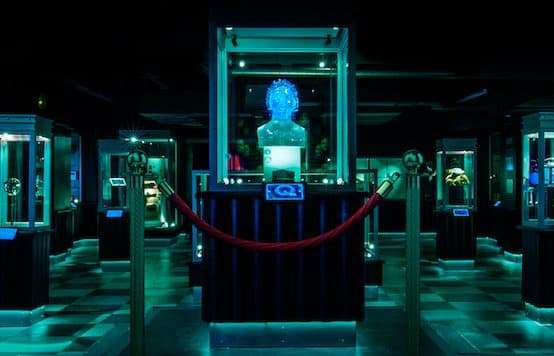
Frank Kermode noticed with typical astuteness that “Apocalypse is part of the modern Absurd.” We have no trouble imagining tidal waves decimating shores, plagues depopulating cities, or aliens enslaving the species. In fact, we’re even saved the burden of creative heavy lifting by letting Hollywood sell apocalypse to us directly. Others can imagine reality-shattering cataclysms for us. And no recent cinematic depiction of apocalypse has been as warmly received by a viewing public hungering for a taste of the “modern Absurd” than the Netflix (via the UK’s Channel 4) show Black Mirror.
Not every Black Mirror episode is strictly apocalyptic. Show creator Charlie Brooker doesn’t always present eschatology on a platter, with life as we understand it irreparably altered and the dawn of a new age foisted upon us. Brooker’s fascination with social technology run amok—contact lenses that record everything, lives determined by social score, cartoon hologram politicians, etc—gives us something more like a dystopia. Premises for iconic episodes, such as an implant that allows you to track and edit the sensory input of your children, are already here in embryonic form. The show gets under our skin because we can clearly see the route from here to there. Everything seems so plausible.
But the show treads water a bit when it depicts an actual apocalypse. Forbes called season four’s “Metalhead” episode featuring human-hunting robots gone berserk “not terribly deep” and “kind of boring.” It’s difficult to imagine the apocalypse. But it’s arguably even more difficult to imagine paradise. And I think this is what disturbs most about Black Mirror: not the terrifying portrayal of a world gone wrong, but the empty and ultimately nihilistic evocation of the good.
No episode was more celebrated as a feel-good rejoinder to an otherwise dour program than season three’s “San Junipero.” The Cliff Notes plot is that two women meet and fall in love in a simulated beachside Californian town where it’s permanently 1987. The place is literally haunted by ghosts, with the simulation acting as receptacle for the minds of the “dead” and the elderly. It so happens that one of the protagonists has locked-in syndrome back in the “real” world and wants to be euthanized so that she can inhabit San Junipero permanently with her new love, despite having a husband and daughter who have passed away without having their own consciousnesses “uploaded.” The women get married and live in San Junipero, one assumes, happily ever after for the rest of time. The show went on to win two Primetime Emmy Awards and was lauded by critics. David Sims at The Atlantic called the episode the “standout of the season.” Salon released a guide to the “best Black Mirror episode yet.”
In the infamous words of Greil Marcus, “What is this shit?”
Uploading human consciousness is a pretty important point of fixation for Charlie Brooker. In the show’s four seasons, an entire stable of episodes has been created featuring the human mind digitized and then uploaded like software, “San Junipero” being only the most praised among them. But the idea reveals a void at the center of Brooker’s vision of the world, simply by virtue of defining human existence in such reductive terms. Simply put, mind can’t be uploaded onto a computer because a mind is much more than data, and a person is much more than his thoughts. Psychologist Robert Epstein writes that humans have a history of using technologies as metaphors to describe human thought—from clay tablets to pneumatic pumps—and adds that “[e]ach metaphor reflected the most advanced thinking of the era that spawned it. Predictably, just a few years after the dawn of computer technology in the 1940s, the brain was said to operate like a computer, with the role of physical hardware played by the brain itself and our thoughts serving as software.”
But the metaphor is just that. Our brains don’t literally “store” symbolic data and our thoughts themselves don’t consist of code. Epstein says that “[t]he faulty logic of the IP metaphor is easy enough to state. It is based on a faulty syllogism—one with two reasonable premises and a faulty conclusion. Reasonable premise #1: all computers are capable of behaving intelligently. Reasonable premise #2: all computers are information processors. Faulty conclusion: all entities that are capable of behaving intelligently are information processors.”
It’s a categorical mistake to think that our entire selves inhabit our thoughts and those thoughts can be reconstructed and allowed to “live” somehow in a machine that crunches numbers. Humans exist inside of human bodies the same way that a tree exists inside of its form. Trying to extract the vegetative essence of the tree from its physical being would be a horrifying mistake. The German philosopher Josef Pieper writes in Death and Immortality that “It was finally expressed by Aristotle…that it is not the soul which is the ‘real man,’ but the existential configuration, the unity of soul and body. This thesis has become the model for a broad strand of Occidental philosophical anthropology.” It’s a lineage that includes Thomas Aquinas arguing homo non est anima tantum, man is not soul alone but is created as a physical being and so physicality is part of his nature. “The soul does not possess the perfection of its own nature except in union with the body,” reasoned Aquinas. Brooker would seem to believe the opposite. We can infer his thoughts on the incarnation.
But for the sake of further argument, let’s momentarily assume that somehow a higher self called “mind” can be extracted from a human body and uploaded as data. The question of death still pursues us in at least two ways. First of all, this virtual California city presumably relies on an exterior physical world to function. It exists on servers, requires power, etc. And so this paradise is really only as eternal as the exterior world that it feeds off of. We still have to reckon with an ending, it’s just been postponed.
But the characters in San Junipero behave as if their new lives will be eternal, a slightly more disturbing prospect than death delayed. What is the meaning of a life that doesn’t end? Terry Eagleton writes in Radical Sacrifice that “Death is one of the few residues of the absolute in a secular age,” and one doesn’t have to be Christian to understand that we interpret life through the grave. It’s the ultimate trajectory that gives shape to our days. Death grants poignancy and heft to our experiences. This is probably one of the most basic precepts of all wisdom writing, secular and religious both. From Socrates insisting that death is a frontier we’re required to bravely face, to Walter Benjamin insisting that existence “unfolds from death, which is not, to be sure, its end but its form,” life has long been considered synonymous with death’s reckoning. It makes about as much sense to talk about life without death as to describe a human without a body.
If anything, a perpetual digital existence sounds more like hell than heaven. The soul-numbing tedium of living the same human life, with no hope of redemption or transcendence, forever, sounds like a punishment. It takes a dedicated narcissist to convince himself that it would be paradise to exist in his current state of mind for all of eternity. Should we really even call it eternity? Surely that term should be reserved for Christian heaven, in which, to quote Eagleton again, “there is no time to be bored because there is no time.” David Byrne was wrong about heaven being a place where nothing happens. It’s a place where “happening” ceases and things are resolved in a permanent unity. Eagleton again: “The Christian idea of heaven involves not immortality in the sense of life without end, but the transcendence of time itself. This is why it is not a question of an ‘afterlife,’ in the sense of an infinite stretch of time in the wake of one’s death. Besides, ‘afterlife’ or ‘survival’ also suggests a placid continuity with the present, which for Christianity is not the best way of trying to grasp the cataclysmic event of the transformation of the flesh.”
All of Black Mirror’s ideas about death and freedom stem from a repudiation of the complex nature of reality itself. Humans are atomized individuals, more free when they’re separated from their bodies and dissociated from the larger symbolic order that gives life meaning. No reckoning with death is required. No transcendence unifying the self with a higher order is wished for. It’s just a dance floor playing 80s pop tunes forever. The freedom that Black Mirror embraces is a “liberation” from meaning itself.
Frank Kermode was only half right. Not being able to imagine heaven is a part of the modern Absurd, also.
Scott Beauchamp’s work has appeared in the Paris Review, Bookforum, and Public Discourse, among other places. His book Did You Kill Anyone? is forthcoming from Zero Books. He lives in Maine.
Sourse: theamericanconservative.com






